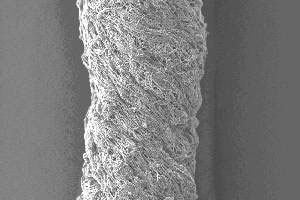| Posted: April 21, 2009 |
Nanofiber fabric could speed up the recovery of injured athletes |
|
(Nanowerk News) A tendon can be one of the most common and frustrating injuries for an athlete - often forcing them to stay away from the sports field for up to eight weeks.
|
|
But now the pioneering research of a University of Manchester student could be about to speed up the recovery process.
|
 |
| A bundle of Electrospun Fibres viewed under a powerful microscope.
|
|
Lucy Bosworth, from the University's School of Materials, has developed a way of spinning biodegradable nanofibres into a 'fabric' that could be used in the body as an artificial tendon.
|
|
The artificial tendon can be surgically grafted onto the site of an injury, where it encourages the injured tendon to grow and repair, before safely degrading.
|
|
And that, researchers believe, would dramatically decrease the time needed for a tendon to heal.
|
|
Currently patients face the choice of having a tendon from another part of the body surgically grafted onto the injury site or completely resting the injured area for a significant period of time.
|
|
Grafting a tendon from another part of the body creates a second site in the body that needs to heal. And the alternative of enforced rest for a number of weeks can be unpopular, especially for those who are committed to their sport.
|
|
Lucy says that using the artificial tendon would take away the need to operate on a second site in the body, which speeds up the recovery time.
|
|
And she believes the alternative approach would be of particular interest to athletes - amateur and professional - who are keen to speed up the time it takes for tendon injuries to heal.
|
|
Lucy is about to start the pre-clinical stage of her artificial tendon research. And she says they could be used in hospitals in less than three years.
|
|
"Tendons have a poor healing response," said Lucy, who is part of the School's Biomaterials Group. "If you damage them they often don't heal back to their original strength, you do get a lot of scar tissue and you can have ongoing pain.
|
|
"The way they are treated at the moment is with a graft where tendon is taken from somewhere else. But this creates two sites of injury or if you have a graft from someone else there is a chance of rejection.
|
|
"With ours it would just be a one-off surgery - you could even have it as a support mechanism before a tendon was to rupture.
|
|
"We are increasingly focusing on early sports injuries. Football and rugby players have a lot of tendon injuries and they really want to reduce their rehabilitation time. They don't want to be sitting around for six weeks waiting for it to heal."
|
|
Lucy creates the artificial tendons with a bio-polymer, which is a degradable polymer than can be used inside the body.
|
|
|
|
Lucy has developed a method of adapting the polymer fibres to a structure that's similar to tendon tissue and mimics natural tissue.
|
|
So far the project has benefited from an investment from the UMIP Premier Fund (UPF), managed by technology Venture Capital specialists, MTI Partners.
|
|
Now the virtual research centre RegeNer8 has made a grant of ?50,000 to the University so that Lucy can continue with her research.
|
|
Professor Sandra Downes, from the School of Materials, said: "This is a major breakthrough, because currently there is no clinically available artificial tendon scaffold.
|
|
"This research is leading edge. And it is a major achievement for a PhD student to come up with something so significant.
|
|
"Our work in this area should lead to significant benefits for patients with tendon injuries in the future and we are pleased that this has been recognised by regeNer8."
|

